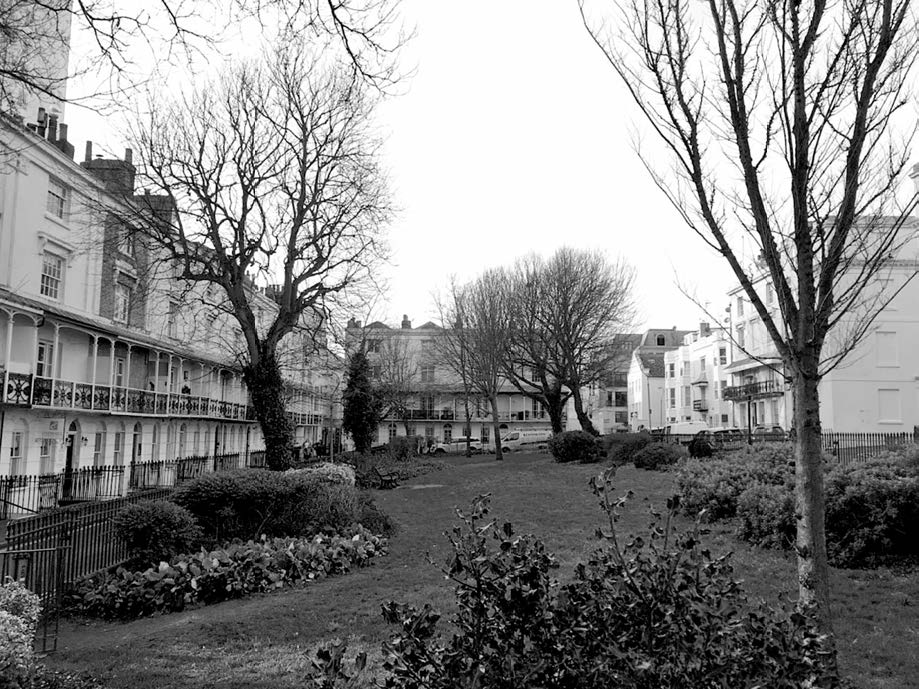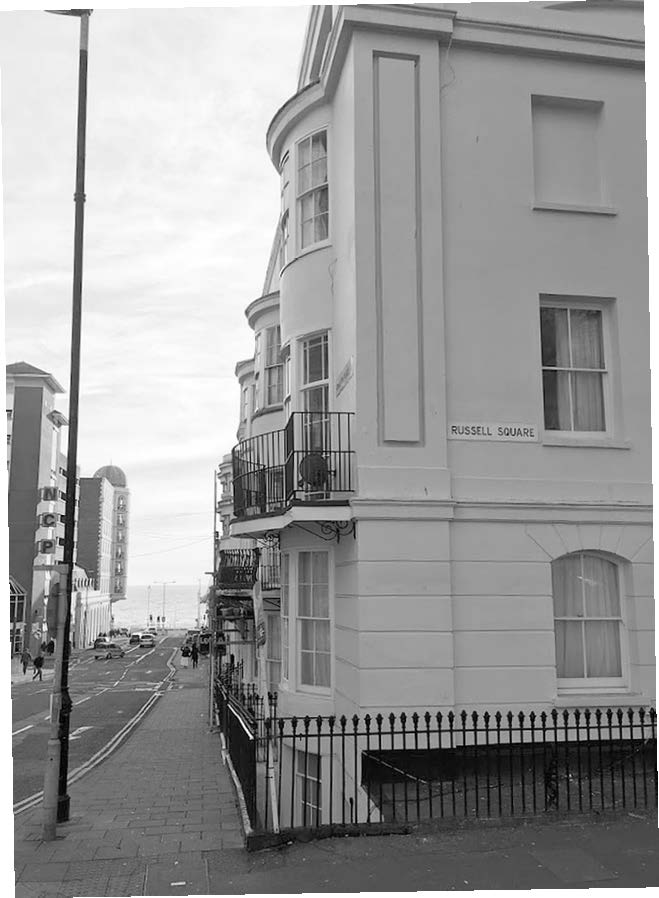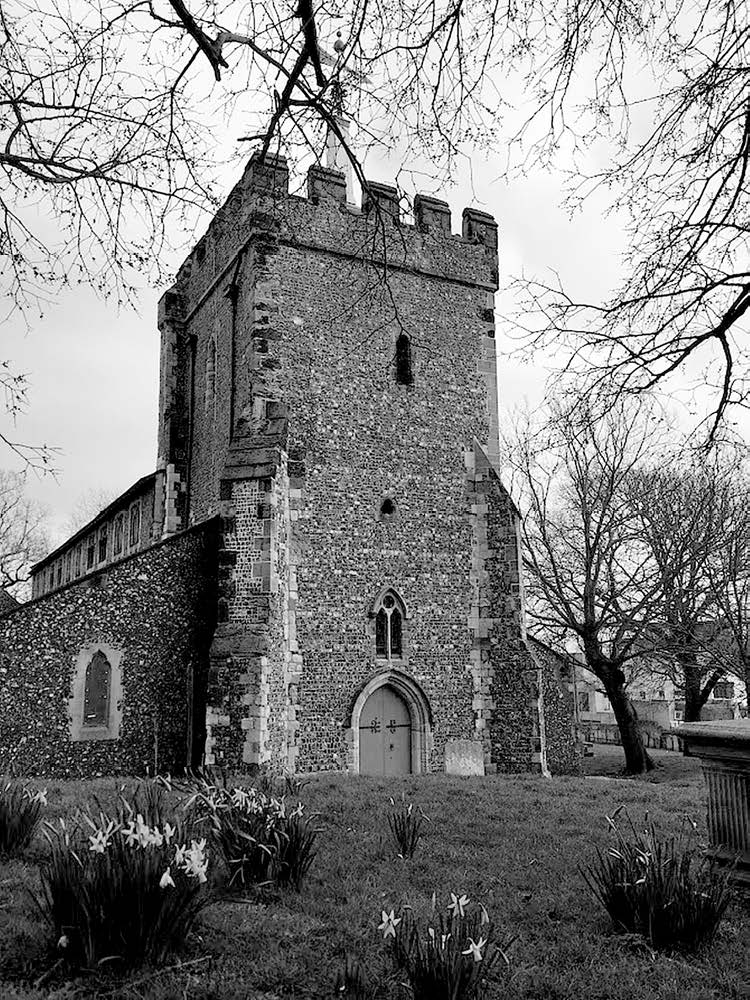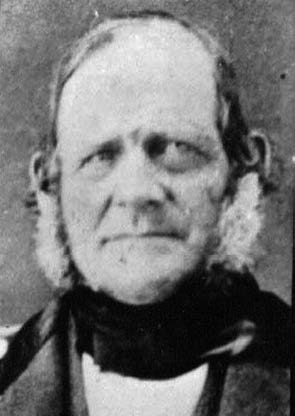Introduction
Mary Goble had her thirteenth birthday somewhere in the North Atlantic Ocean bound for America. She was the oldest of six children traveling with their parents on the sailing ship Horizon from Liverpool to Boston, en route to the Great Salt Lake Valley. Edwin was eleven, Caroline was eight, Harriet was six, James was four, and little Fanny was two. A seventh child—the firstborn—had been born the year before Mary’s birth but died at the age of eight months and lay buried back in England. Mary’s mother was expecting her eighth child when the family left their home in England and set out for America.
 Russell Square in 2020. The Goble family lived at 53 Russell Square before emigrating. Courtesy of Ann H. Rowan.
Russell Square in 2020. The Goble family lived at 53 Russell Square before emigrating. Courtesy of Ann H. Rowan.
William Goble and Mary Penfold were both born in Sussex, near Brighton, England. They came from farming families but saw better opportunities in the growing seaside resort of Brighton, and it was there that they married in 1841 at St. Nicholas Church, a stately building that was already nearly five hundred years old. Brighton in the 1850s was a prosperous and growing town with a number of trades and a healthy tourist industry. A direct rail connection enabled Londoners to make day trips to the Brighton seashore and its famed Royal Pavilion. William Goble was a “greengrocer” (a retailer of fresh fruits and vegetables) and had a home at 53 Russell Square, just about two blocks from the sea. It was a neighborhood filled with merchants and craftsmen. The Gobles’ neighbors included a coach maker, two coach painters, a tailor, two butchers, a carpenter, a harness maker, a confectioner, a tinsmith, a saddler, a miller, and a dairyman.[1]
Each of William and Mary’s seven children was christened at St. Nicholas in a beautiful carved stone font that dates back to AD 1170. Mary, the oldest living child at the time they left Brighton, was christened on 23 July 1843; Fanny, the youngest, was christened in July 1854.
 View to the sea from Russell Square. Courtesy of Ann H. Rowan.
View to the sea from Russell Square. Courtesy of Ann H. Rowan.
By the time Fanny was christened at St. Nicholas, however, the Goble family had come in contact with a new religion. William’s sister Harriet, who was seven years younger than William, read a copy of the Book of Mormon that had been left with her brother-in-law. She walked five miles the next Sunday to hear an elder of The Church of Jesus Christ of Latter-day Saints preach, reporting, “When the elder stood in the doorway and read the first hymn in the book, the scales of darkness fell from my mind and visions of eternity were opened to my view, and tears of joy fell from my eyes.” She was baptized the following Sunday, 3 February 1850, in the River Ouse just outside of Brighton.[2]
Two more of William’s younger sisters, Mary Ann and Matilda, were baptized that same year along with their husbands. William’s older sister and her husband, Fanny and John Wood, were baptized in 1852.
Not until March 1855 did William and his wife accept baptism.[3] By then Mary Ann (who was still single) and Matilda (with her husband, Leonard Matless) had already immigrated to America. They had left together in 1853 on the sailing ship Golconda, landed in New Orleans, and taken a riverboat up to Keokuk, Iowa. Matilda and Leonard found Keokuk to their liking and remained there, so Mary Ann headed west alone with a company of Saints. On the trek she met a young widower, Thomas Carter, and they were married at Fort Laramie in present-day Wyoming while on their way to the Salt Lake Valley.
 St. Nicholas Church, Brighton, Sussex, England, where Mary was christened (and her parents were married). Courtesy of Ann H. Rowan.
St. Nicholas Church, Brighton, Sussex, England, where Mary was christened (and her parents were married). Courtesy of Ann H. Rowan.
Fanny and John Wood sailed from England on the Samuel Curling with their six children shortly after the baptism of William and Mary in the spring of 1855. The Woods traveled in a wagon company from Mormon Station, Kansas (near Atchison), to the Salt Lake Valley, arriving in late September of 1855. They settled in Farmington, north of Salt Lake City.
Young Mary and her brother Edwin were baptized as members of the Church in November 1855 in Brighton. Seven months later their father sold the greengrocer business, and the family left Brighton forever.
Mary was only one of an estimated sixty thousand Latter-day Saint emigrants[4] who traveled at least part of the distance from Iowa to Salt Lake City on foot between 1847 and 1869. The first pioneer company, led by Brigham Young, arrived in the Salt Lake Valley in July of 1847. Thirteen more companies of pioneers arrived that same year, the vanguard of one of the greatest mass migrations in modern history.
Emigrants came from five continents and a score of countries. Many of them were poor, and the cost of the journey from Europe, South Africa, India, or Australia stretched their resources. Helping the poor gather to Zion was a constant focus of President Young. It was a daunting challenge; in the early days of the Utah Territory, those who had already immigrated to Utah were struggling to survive and create a viable economy, and there was little surplus to send abroad. In October 1849, the Church created the Perpetual Emigrating Fund (PEF) to assist those desiring to gather to Zion but lacking the financial means to do so. In addition to providing financial assistance, the Church maintained a shipping agency in Liverpool and managing conductors at ports of entry in the United States so emigrants could then be sent on to an outfitting point in the West.
The Perpetual Emigrating Fund was a significant factor in enabling thousands of emigrants to come to Utah, but the need for financial assistance was always greater than the supply. In 1855 the PEF spent $150,000 assisting emigrants from Europe, but drought and grasshoppers in Utah reduced the harvests that fall by more than a third, with a related reduction in tithing and donations. Discussions were held regarding curtailing emigration for the following year. On 30 September 1855, President Young wrote to President Franklin D. Richards of the European Mission, “I have been thinking how we should operate another year. We cannot afford to purchase wagons and teams as in times past.”[5] He then proposed an idea that had been considered at least since 1851—the use of hand-drawn carts rather than oxen and wagons. In fall 1851 Brigham and the First Presidency had called for the use of handcarts. “Some of the children of the world have crossed the mountains and plains, from Missouri to California, with a pack on their back to worship their God—Gold. Some have performed the same journey with a wheelbarrow, some have accomplished the same with a pack on a cow,” wrote the Presidency. “Families might start from the Missouri River, with cows, handcarts, [and] wheelbarrows,” they urged.[6] But despite such urging, no handcart companies had been organized.
However, with the lack of funds in 1856, the First Presidency determined to organize PEF-funded handcart companies. The plan was laid out in great detail, and the first handcart company, consisting of 274 Saints, set out from Iowa City on 9 June 1856 under the leadership of Edmund L. Ellsworth. A second company of 221 left two days later under the leadership of Daniel D. McArthur. Both companies entered the Salt Lake Valley on 26 September, having traveled thirteen hundred miles in less than seventeen weeks. The third handcart company, sometimes referred to as the Welsh company, consisted of 320 people and 64 handcarts under the direction of Edward Bunker. They left Iowa City on 28 June and arrived in Salt Lake City on 2 October, a journey of ninety-five days.
While these companies reported that provisions were low and strict rationing was required even with significant resupply from the valley, they had, as expected, traveled somewhat faster than most wagon trains, not having the time-consuming burden of caring for a large number of animals. And the mortality rate in the first three handcart companies was similar to that typically experienced by the wagon companies.[7]
The fourth and fifth handcart companies were captained respectively by James G. Willie and Edward Martin. It is their story—the tragedy that befell them as they were caught in early blizzards in Wyoming and the heroism of their rescuers—that is etched into the collective memory of modern Latter-day Saints worldwide. Although the use of handcarts was limited to a total of ten companies between 1856 and 1860,[8] it is the image of handcart pioneers, and particularly of the Willie and Martin companies, that has become the most prominent pioneer image in the minds and hearts of Latter-day Saints. The Willie and Martin companies, together with the William B. Hodgetts and John A. Hunt wagon trains, left late in the season—a full month later than the third handcart company—and about two thousand[9] Saints were caught in the October blizzards. It is their experience that has come to symbolize the entire emigration, so much so that the very notion of a modern-day “pioneer trek” is a handcart trek—and for many of the same reasons that handcarts were first used: they are relatively simple and inexpensive.[10]
Mary Goble’s short narrative unfolds within the drama of the suffering of these handcart companies. Her family was not a part of the PEF-funded handcart companies: William paid the £35.50 cost of the trans-Atlantic voyage and purchased “two yoke of oxen, one yoke of cows, [and] a wagon and tent” in Iowa, according to Mary, presumably from money he received from the sale of his business in Brighton. But in the weeks following the blizzard of 19 October, the Hunt wagon company, the Hodgetts wagon company, and the Martin handcart company continued to travel close together as they slowly made their way to Salt Lake City with the assistance of rescuers.
Although by late September the hot summer days had faded and the mornings were “cold and frosty,”[11] the weather was still mild when Franklin D. Richards (the thirty-five-year-old member of the Quorum of the Twelve Apostles who, as president of the European Mission, had organized the European immigration in 1855–56) arrived in Salt Lake City on 4 October and reported that additional companies of emigrants were still on the plains. Church leaders were already aware that the Smoot wagon company, carrying freight and including several emigrants, was still on the plains, and they had sent resupply wagons to meet that company.[12] The news that four additional emigrant companies were still on the plains came as a surprise to Church leaders in Salt Lake City. “We had no idea there were any more companies upon the Plains,” wrote Brigham Young.[13] Consequently, no resupply wagons had been dispatched east to assist them, and by this point they were almost certainly running out of food.
 Mary’s father, William Goble. Courtesy of FamilySearch.
Mary’s father, William Goble. Courtesy of FamilySearch.
The first members of the rescue party left Salt Lake City in good weather on 7 October. But the mild weather soon yielded to the bitter cold of an early winter. From the first blizzard on 19 October to the arrival of the last stragglers in Salt Lake City on 15 December, snow and freezing temperatures were the constant companions of pioneers and rescuers alike. At least twenty-five members of the Hunt company died on the trail—three of them from the Goble family.[14] More than a hundred members of the Martin company died along the way—exact numbers are difficult to come by because record keeping gave way to survival.[15] The smaller Hodgetts company lost eight to ten members, while the Willie company suffered about seventy deaths. Upon arriving in the valley, Jesse Haven, a returning missionary who served as first counselor to Edward Martin that spring aboard the ship Horizon, noted, “When I came out of Emigration Canyon, I shed tears of joy to [be] so near home.”[16]
As one pioneer of tens of thousands, Mary Goble did not consider her experience extraordinary. It was not until late in her life that she wrote the simple memoir from which this excerpt is taken.[17] As a reminiscence written nearly fifty years after the events, there are certain details and dates that are at odds with contemporary records and other accounts (many of which are also reminiscences written years after the fact and so not wholly reliable). Yet, on the whole, Mary’s recollections were remarkably accurate.
Her memoir was written by hand in a ledger dated 1903; it covers fourteen pages, including some entries made at a later date. Her account of traveling from England to Salt Lake City—the focus of this book—covers about four pages.
An edited transcription of her autobiography was included in volume 4 of the six-volume Treasures of Pioneer History, published between 1952 and 1957, as well as in volume 13 of the twenty-volume compilation Our Pioneer Heritage, published between 1958 and 1977. Typewritten transcripts of her memoir, edited and enlarged, were held by family members, and her story was often told at family gatherings; but it was not until the publication of her memoir in the 1974 collection A Believing People[18] that her story became widely available. Portions of her autobiography have since been printed in a variety of publications, and President Gordon B. Hinckley—her grandson-in-law—mentioned her story in general conference. A search of the Ensign magazine shows at least a dozen references to Mary Goble, including four in general conference addresses.[19] Her story has been recounted or mentioned in manuals for Primary, Young Women, and Aaronic Priesthood. Just as the Martin and Willie handcart pioneers have become the icons of the entire pioneer migration, this simple narrative of Mary Goble Pay stands out as an iconic account from the ill-fated companies of 1856.
This volume endeavors to provide background on the events mentioned by Mary, together with dates and names that help flesh out the story, and to put it all in context with the scene that unfolded across the plains of Wyoming, particularly in October and November of 1856, when there were over fifteen hundred pioneers (in four companies) strung out across two hundred miles of high prairie—the Willie company farthest west and the Hodgetts, Martin, and Hunt companies to the east. At the same time, rescue teams were traveling east with assistance, and express riders were moving back and forth as fast as the weather and their horses would allow, trying to make sense of what was happening and get information and help to where they were needed most. The rescuers, caught in the same storms as the emigrants, found their own lives in jeopardy, and the movement of so many groups in various directions makes for a complex story.[20]
But much of the power of Mary’s narrative lies in its simplicity and brevity: a father and mother with six young children and a seventh on the way, converts of just a few months, leave their comfortable home in England in May. In December, the father and four badly frozen but surviving children arrive in the Salt Lake Valley with the mother’s frozen body in the wagon; three children lie buried on the trail. Mary’s narrative endures as a moving story of a young girl and her family who were willing to sacrifice everything for the gospel.
Notes
[1] See “England and Wales Census, 1851” (database with images), www.familysearch.org, film 101795967, image 390 of 1317; from “1851 England, Scotland and Wales census,” database and images, http://
[2] “Harriet Goble” (autobiographical sketch, n.p., n.d.), www.familysearch.org/
[3] FamilySearch shows Mary Penfold’s baptismal date as 1 January 1855 and William Goble’s as 27 March 1855 (www.familysearch.org).
[4] Researchers have variously estimated the total from between fifty-one and eighty thousand. See Melvin L. Bashore and H. Dennis Tolley, “Mortality on the Mormon Trail, 1847–1868,” BYU Studies Quarterly 53, no. 4 (2015): 110n6. The Pioneer Database website, maintained by the Church History Department of The Church of Jesus Christ of Latter-day Saints, includes the most comprehensive list of pioneers who traveled to Utah between 1847 and the coming of the railroad in 1869. Historians estimate that more than sixty thousand individuals emigrated.
[5] Brigham Young office files, 1832–1878 (bulk 1844–1877); General Correspondence, Outgoing, 1843–1876; 1855 July–September; CHL, https://
[6] “Sixth General Epistle of the Presidency of the Church of Jesus Christ of Latter-day Saints,” Millennial Star 14, no. 2 (15 January 1852): 23.
[7] See Bashore and Tolley. Detailed statistics are in the database referenced in the article.
[8] By 1861 the Church and the PEF were able to provide “Church trains”—wagon trains that would go east and pick up emigrants at the staging area and bring them to the valley.
[9] The Pioneer Database gives the following numbers for the four companies caught in the early storms: Willie handcart company, 513; Hodgetts wagon company, 173; Martin handcart company, 641; Hunt wagon company, 285—for a total of 1,612 Saints. In addition, the Abraham O. Smoot wagon train, which was carrying freight to Utah, began with about 97 participants, including a number of emigrants, and was caught in the October storms. The site also lists 365 members of the rescue parties, bringing the total to 2,074 Saints.
[10] Information on the Church website comparing the Philemon C. Merrill wagon company of 1856 and the Daniel McArthur handcart company shows an estimated cost per person of ninety-three dollars for the wagon company and thirteen dollars for the handcart company. “Wagons vs. Handcarts,” https://
[11] Hunt Journal, 25 September 1856.
[12] The Smoot company encountered relief wagons on 2 October, just beyond the last crossing of the Platte River near where the Hodgetts, Martin, and Hunt companies would be trapped by the snow eighteen days later. Smoot requested additional supplies, and the additional relief wagons reached the company on or about 18 October, just before the blizzard of 19 October; the company was then about three days’ travel east of South Pass. They arrived in Salt Lake City on 9 November just ahead of the Willie company. Franklin D. Richards had met resupply teams on 27 and 28 September and counseled them to cache their flour and go on to meet the Willie company, but they apparently turned back before reaching the Willie company. See Richards’s report in Deseret News, 22 October 1856, and Burton, 30 October 1856).
[13] Brigham Young to Orson Pratt, letter dated 30 October 1856, Millennial Star, 19:7, 99.
[14] Bashore and Tolley identify twenty-five deaths that occurred after leaving Iowa City, with a possible two others. Deaths which occurred before leaving the staging area are not included in Bashore’s and Tolley’s analysis. Consequently, their count does not include Mary’s little sister who died at the Iowa City campground before the trek began.
[15] Bashore and Tolley list the deaths in the Martin company between 76 and 111, a mortality rate of between 12 and 17 percent.
[16] Haven, entry dated 15 December 1856.
[17] Melvin Bashore notes that the story of the companies caught in the early storms was not generally told until a couple of decades had passed, possibly because the memories were still so painful. See Melvin Bashore, “On the Heels of the Handcart Tragedy: Mormondom’s Forgotten 1856 Wagon Companies,” Annals of Wyoming 68, no. 3 (Summer 1996): 39–40.
[18] Richard H. Cracroft and Neal A. Lambert, eds., A Believing People: Literature of the Latter-day Saints (Provo, UT: Brigham Young University Press, 1974). The compilation was reviewed by Eugene England in BYU Studies in 1975. In his review, England opined that most of the literature of the Latter-day Saints was not “great” in the sense that the writing of Milton or Shakespeare is great: “I don’t believe [God] held his highest spirits in reserve that they might come forth in the latter days as our great writers, certainly not as Ernest Hemingways or Norman Mailers, but not even as Miltons or Shakespeares, who, whatever they may have contributed to the aesthetic pleasure and sensitivity or even moral and philosophical insight of us all, most likely have brought few, if any, souls to Christ. That after all, is God’s first concern and would seem to be his primary mission for his ‘highest spirits.’ Yes, I believe God held in reserve the sensitive and articulate Apostle Parley P. Pratt—and also the plain-spoken and stubbornly courageous handcart pioneer, Mary Goble Pay—both of whom produced good (not ‘great’) literature that is included in this anthology; but the reason they were sent to us in in these latter days and the reason I most value them is not for the greatness of their writing, but for the greatness of their lives.” Eugene England, “A Believing People: Literature of the Latter-day Saints, ed. Richard H. Cracroft and Neal E. Lambert,” BYU Studies 15, no, 3 (1975): 367.
[19] Gordon B. Hinckley, “Our Mission of Saving,” general conference, October 1991; Gordon B. Hinckley, “The Faith to Move Mountains,” general conference, October 2006; “Experiences Worth Remembering” (Brigham Young University devotional address), 31 October 2006; Virginia H. Pearce, “Faith Is the Answer,” general conference, October 1994; and Elaine S. Dalton, “It Shows in Your Face,” general conference, April 2006.
[20] There were many other travelers on the road in September and into October of 1856. See Sidebar 4: Life on the Trail.
